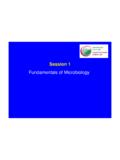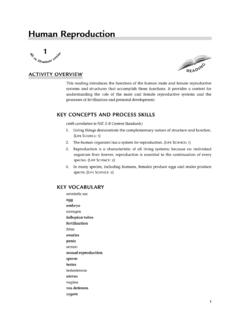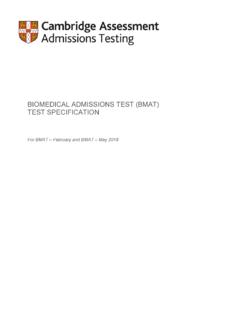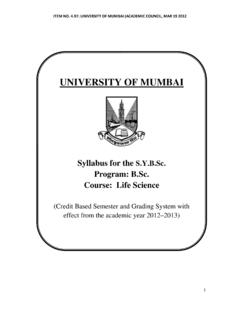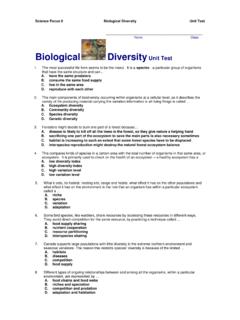Transcription of INTRODUCTION TO MYCOLOGY - Sridhar Rao
1 INTRODUCTION TO MYCOLOGY The term " MYCOLOGY " is derived from Greek word "mykes" meaning mushroom. Therefore MYCOLOGY is the study of fungi. The ability of fungi to invade plant and animal tissue was observed in early 19th century but the first documented animal infection by any fungus was made by Bassi, who in 1835 studied the muscardine disease of silkworm and proved the that the infection was caused by a fungus Beauveria bassiana. In 1910 Raymond Sabouraud published his book Les Teignes, which was a comprehensive study of dermatophytic fungi.
2 He is also regarded as father of medical MYCOLOGY . Importance of fungi: Fungi inhabit almost every niche in the environment and humans are exposed to these organisms in various fields of life. Beneficial Effects of Fungi: 1. Decomposition - nutrient and carbon recycling. 2. Biosynthetic factories. The fermentation property is used for the industrial production of alcohols, fats, citric, oxalic and gluconic acids. 3. Important sources of antibiotics, such as Penicillin. 4. Model organisms for biochemical and genetic studies.
3 Eg: Neurospora crassa 5. Saccharomyces cerviciae is extensively used in recombinant DNA technology, which includes the Hepatitis B Vaccine. 6. Some fungi are edible (mushrooms). 7. Yeasts provide nutritional supplements such as vitamins and cofactors. 8. Penicillium is used to flavour Roquefort and Camembert cheeses. 9. Ergot produced by Claviceps purpurea contains medically important alkaloids that help in inducing uterine contractions, controlling bleeding and treating migraine. 10. Fungi (Leptolegnia caudate and Aphanomyces laevis) are used to trap mosquito larvae in paddy fields and thus help in malaria control.
4 Harmful Effects of Fungi: 1. Destruction of food, lumber, paper, and cloth. 2. Animal and human diseases, including allergies. 3. Toxins produced by poisonous mushrooms and within food (Mycetism and Mycotoxicosis). 4. Plant diseases. 5. Spoilage of agriculture produce such as vegetables and cereals in the godown. 6. Damage the products such as magnetic tapes and disks, glass lenses, marble statues, bones and wax. General properties of fungi: 1. They are eukaryotic; cells contain membrane bound cell organelles including nuclei, mitochondria, golgi apparatus, endoplasmic reticulum, lysosomes etc.
5 They also exhibit mitosis. 2. Have ergosterols in their membranes and possesses 80S ribosomes. 3. Have a rigid cell wall and are therefore non-motile, a feature that separates them from animals. All fungi possess cell wall made of chitin. 4. Are chemoheterotrophs (require organic compounds for both carbon and energy sources) and fungi lack chlorophyll and are therefore not autotrophic. 5. Fungi are osmiotrophic; they obtain their nutrients by absorption. 6. They obtain nutrients as saprophytes (live off of decaying matter) or as parasites (live off of living matter).
6 7. All fungi require water and oxygen and there are no obligate anaerobes. 8. Typically reproduce asexually and/or sexually by producing spores. 9. They grow either reproductively by budding or non-reproductively by hyphal tip elongation. 10. Food storage is generally in the form of lipids and glycogen. Classification of fungi: Fungi were initially classified with plants and were a subject of interest for botanists; hence the influence of botany can be seen on their classification. In 1969 Whittaker classified all living organisms into five kingdoms namely Monera, Protista, Fungi, Plantae and Animalia.
7 Traditionally the classification proceeds in this fashion: Kingdom - Subkingdom - Phyla/phylum - Subphyla - Class - Order - Family - Genus- Species This classification is too complicated to be dealt here. There are alternate and more practical approaches, one based on sexual reproduction and the other based on morphology of the thallus (vegetative structure). Based on Sexual reproduction: 1. Zygomycetes: which produce through production of zygospores. 2. Ascomycetes: which produce endogenous spores called ascospores in cells called asci.
8 3. Basidiomycetes: which produce exogenous spores called basidiospores in cells called basidia. 4. Deuteromycetes (Fungi imperfecti): fungi that are not known to produce any sexual spores (ascospores or basidiospores). This is a heterogeneous group of fungi where no sexual reproduction has yet been demonstrated. Based on Morphology: 1. Moulds (Molds): Filamentous fungi Eg: Aspergillus sps, Trichophyton rubrum 2. Yeasts: Single celled cells that buds Eg: Cryptococcus neoformans, Saccharomyces cerviciae 3. Yeast like: Similar to yeasts but produce pseudohyphae Eg: Candida albicans 4.
9 Dimorphic: Fungi existing in two different morphological forms at two different environmental conditions. They exist as yeasts in tissue and in vitro at 37oC and as moulds in their natural habitat and in vitro at room temperature. Eg: Histoplasma capsulatum, Blastomyces dermatidis, Paracoccidiodes brasiliensis, Coccidioides immitis Some 200 "human pathogens" have been recognized from among an estimated million species of fungi. Morphology of fungi: Fungi exist in two fundamental forms; the filamentous (hyphal) and single celled budding forms (yeast).
10 But, for the classification sake they are studied as moulds, yeasts, yeast like and dimorphic fungi. All fungi have typical eukaryotic morphology. They have rigid cell wall composed of chitin, which may be layered with mannans, glucans and other polysaccharides in association with polypeptides. Some lower fungi possess cellulose in their cell wall. Some fungi such as Cryptococcus and yeast form of Histoplasma capsulatum possess polysaccharide capsules that help them to evade phagocytosis.





